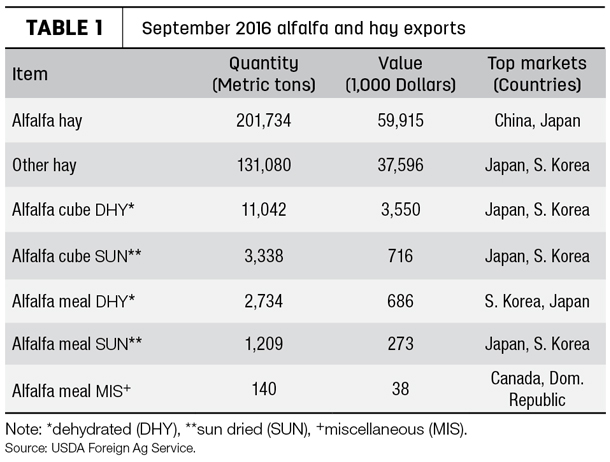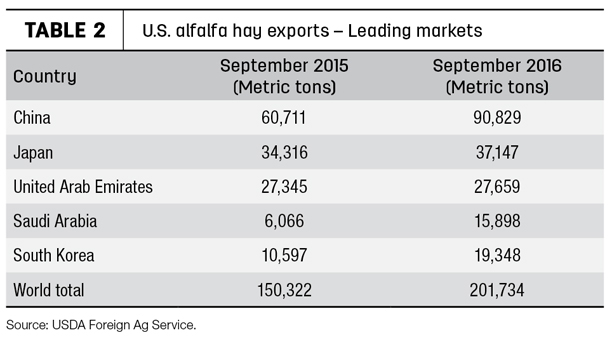The bankruptcy of shipping giant Hanlin and reports China has developed substantial hay stockpiles weakened U.S. alfalfa exports in September. Nonetheless, monthly exports still posted a 34 percent volume gain compared to a year earlier. Shipments totaled 201,734 metric tons (MT), the lowest volume since June, but the fifth consecutive month above 200,000 MT (Table 1).

Alfalfa hay exports to China, Saudi Arabia and South Korea were well above a year ago, with sales to Japan and the United Arab Emirates marginally higher (Table 2).

With lower volumes, September alfalfa export values were also down to $59.9 million, also the lowest total since June.
At 131,080 MT, September exports of other hay were the highest since November 2015. Those sales were valued at $37.6 million, the highest since March.
Shipments of dehydrated alfalfa cubes and meal were up compared to August, but sales of other alfalfa products were lower.
With strong 2016 U.S. hay production, farmer and supplier inventories are large, and marketers expect prices to decline into 2017, said Christy Mastin with hay exporter Eckenberg Farms, Inc., Mattawa, Washington.
The September 2016 U.S. average price paid to U.S. alfalfa hay producers at the farm level was $137 per ton, down $1 from August and $20 less than a year earlier. The September U.S. average price for other hay averaged $114 per ton, down $2 from August but unchanged from September 2015.
Off shore, the domestic supply of hay has been harvested in China, Japan and Korea, main U.S. export markets. Rice straws and grasses are competing directly with imported hay.
China has also seen milk prices drop, so higher-priced alfalfa hay is not attractive to purchase. There have been large volumes of alfalfa imported into China to this point, and not all has been sold to farmers in the country. That’s creating build-ups in inventory, and concern prices will be pushed lower, Mastin said.
U.S. exporters are watching harvest conditions in Australia. The early harvest was impacted by rain, reducing hay quality. What impact that has on the later harvest remains to be seen. The Australian oaten hay also competes directly with timothy and other grasses and, to a lesser extent, alfalfa, from the U.S. ![]()

-
Dave Natzke
- Editor
- Progressive Forage
- Email Dave Natzke











